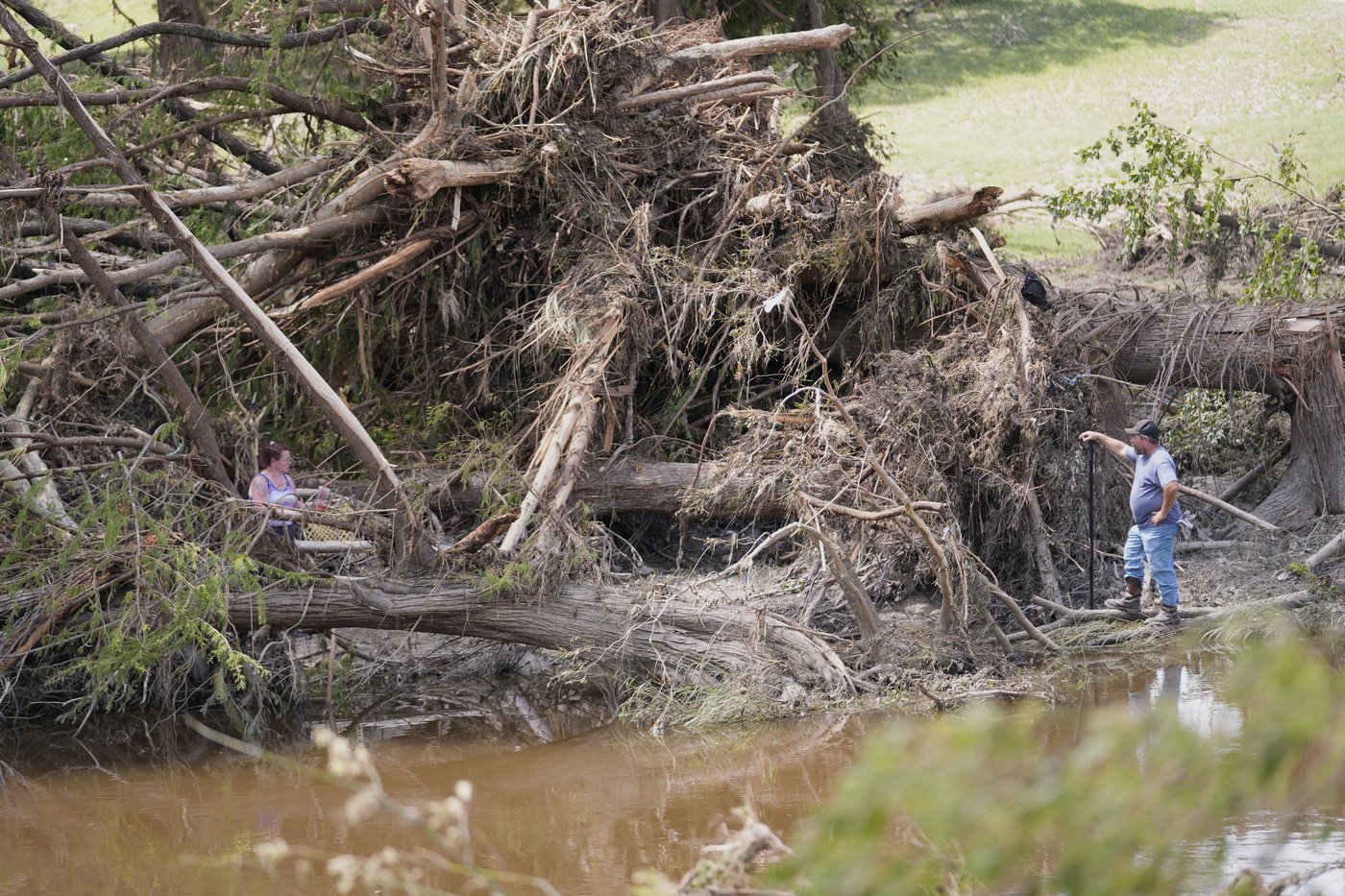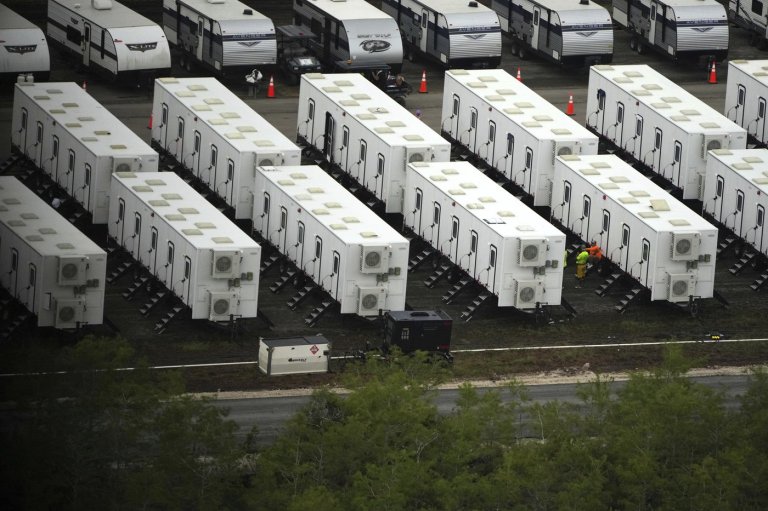
A decade of missed opportunities: Texas couldn’t find $1M for flood warning system near camps
KERRVILLE, Texas (AP) — Over the last decade, an array of Texas state and local agencies missed opportunities to fund a flood warning system intended to avert a disaster like the one that killed dozens of young campers and scores of others in Kerr County on the Fourth of July.
The agencies repeatedly failed to secure roughly $1 million for a project to better protect the county’s 50,000 residents and thousands of youth campers and tourists who spend time along the Guadalupe River in an area known as “flash-flood alley.” The plan, which would have installed flood monitoring equipment near Camp Mystic, cost about as much as the county spends on courthouse security every two years, or 1.5% of its annual budget.
Meanwhile, other communities had moved ahead with sirens and warning systems of their own. In nearby Comfort, a long, flat-three minute warning sound signifying flood danger helped evacuate the town of 2,000 people as practiced.
Previous floods provided warnings
A deadly 2015 Memorial Day flood in Kerr County rekindled debate over whether to install a flood monitoring system and sirens to alert the public to evacuate when the river rose to dangerous levels. Some officials, cognizant of a 1987 flood that killed eight people on a church camp bus, thought it was finally time.

But the idea soon ran into opposition. Some residents and elected officials opposed the installation of sirens, citing the cost and noise that they feared would result from repeated alarms.
County commissioners sought compromise. They moved forward with a plan for a warning system without sirens, which would improve flood monitoring with a series of sensors but leave it up to local authorities to alert the public. They didn’t want to pay for it on their own but found little help elsewhere.
The county’s largest city, Kerrville, declined to participate in a joint grant application that would have required a $50,000 contribution. The state’s emergency management agency twice passed over the county’s request for hazard mitigation funding, citing a deficiency in the application and then backing communities ravaged by Hurricane Harvey in 2017.
The state’s flood infrastructure fund later offered an interest-free loan for the project — but that plan was seen as too stingy and turned down by the agency in charge of managing the watershed.
A failure to act

Without the flood monitoring system, the county was left vulnerable when rains pounded the area in the early morning hours of July 4 and the river rapidly rose.
“There wasn’t enough fight in them, and there needs to be more fight this time,” said Nicole Wilson, a San Antonio mother who pulled her daughters out of an area camp ahead of the flooding and who launched an online petition calling on Kerr County to install the sirens. “Whether it’s a combination of city, state and federal funding, there simply can’t be the answer of ‘no’ this time.”
Local authorities and Texas Gov. Greg Abbott have urged the public not to point fingers after the flooding, which killed at least 120 people and left scores more reported missing.
“I would be willing to talk about it but not yet. It’s just too raw right now,” said Glenn Andrew, a former Kerrville city council member who voted in 2017 to pull the city out of the grant proposal for the project. “My preference is to look forward to the future.”
A spokesperson for Texas Lt. Gov. Dan Patrick said Wednesday that lawmakers, who begin a special session later this month, would approve funding to cover such projects in the future.

“The state will provide emergency warning sirens where needed,” Patrick spokesperson Steven Aranyi wrote in an email.
But some anger is starting to boil over. Raymond Howard, a city council member in Ingram, Texas, in Kerr County, said Wednesday it’s “unfathomable” that county officials never took action despite repeatedly talking about it.
“That’s just mind-boggling,” he said. “It’s unfathomable that they never worked on it. If it comes down to funding, they’re constantly raising taxes on us for other stuff. This is more important. This is lives. This is families. This is heartbreaking.”
Howard, who lives in a home along the Guadalupe River, said any action now would come too late for those who have died.
Another chance ended in diverted funds

Kerr County requested a flood warning system grant in 2016 through the Texas Division of Emergency Management’s hazard mitigation program, which is supported by Federal Emergency Management Agency funding to help communities reduce their risk.
But that application was rejected because it did not meet federal specifications, including one that required the county have a current hazard mitigation plan on file, Texas emergency management spokesperson Wes Rapaport said.
The county hired a consultant and an engineering firm to help prepare another application for the project for the next funding cycle in 2017. The system outlined in the county’s preliminary plan would provide “mass notifications to citizens about high water levels and flooding conditions throughout Kerr County.”
At targeted low water crossings within Kerr County, sensors connected to monitoring stations would transmit a signal that would notify local officials and emergency management agencies of the rising water levels. Officials envisioned using that information to alert the public and call their contacts at youth camps and RV parks during emergencies.
But after Hurricane Harvey caused record flooding in Houston and other areas of Texas in August 2017, “funding was distributed to counties that fell under the disaster declaration, which Kerr County was not included on,” Rapaport said.
The City of Kerrville’s council voted 4-0 to decline to participate in the grant proposal, balking at its planned $50,000 contribution, minutes show.
Texas voters created a new funding source for such projects in 2019, backing a constitutional amendment to create a state flood infrastructure fund with an initial $800 million investment.
The Upper Guadalupe River Authority, which manages the watershed in Kerr County, revived the project last year with a $1 million initial request for funding. The Texas Water Development Board, which oversees the fund, offered a $50,000 grant and a $950,000 interest-free loan for the rest of the project.
The river authority declined to pursue the funding, saying the terms were not favorable.
___
Foley reported from Iowa City, Iowa; Keller from Albuquerque, New Mexico; and Mustian from Miami. Associated Press reporter Claudia Lauer contributed to this report from Philadelphia.
Join the Conversation!
Want to share your thoughts, add context, or connect with others in your community? Create a free account to comment on stories, ask questions, and join meaningful discussions on our new site.













Leave a Reply
You must be logged in to post a comment.